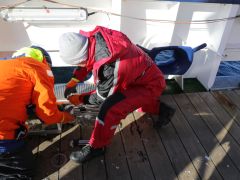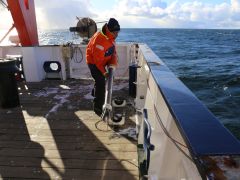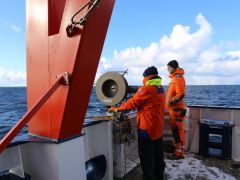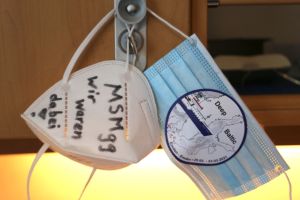
Home run for the RV Maria S. Merian:
Research vessel sets off towards the Baltic Sea ice
for the "Deep Baltic" mission
05.03.2021 – We leave the past and its sediments and get to the water
Looking for signs of deep water formation, the microstructure probe will now help. It is balanced in a way that - once it is launched - it falls freely through the water column at a specific speed, measuring conductivity (salinity), temperature, and oxygen content of the water. But in addition, it also detects small-scale current patterns - turbulence. This is exactly the information we need. Toralf Heene and Volker Mohrholz today deployed the microstructure probe, the "MSS", for the first time with the Deep Baltic mission. This is a laborious business, because in order to get a spatial image of the microstructures in the water, the probe has to be lowered into the water and brought up again several times in succession. The repeated measurements also ensure that the transient processes of turbulence are actually recorded. Above all, the sinking velocity must be correct, ideally 0.4 to 0.6 m per second. If the probe falls faster, the interfering signals become too large to detect the turbulence properly.
Later, when we are on the ice, we will implement this in shift operation over a drilled ice hole. Today - for the test operation - 90 minutes on the winch in the icy wind will suffice for now.
Why are we so keen on turbulence? Turbulence is crucial for the formation of deep water, which is what Deep Baltic is all about. They trigger the vertical motion in the water beneath the ice we need for deep circulation.
Text and photos by Barbara Hentzsch (IOW) | click photos to enlarge
| Expedition: | MSM99 |
| Mission: | Deep Baltic |
| Start: | 25.02.2021 - Emden |
| Destination: | 23.03.2021 - Emden |
Maria S. Merian: current position
By the way, since March 5 we are rid of the masks:



